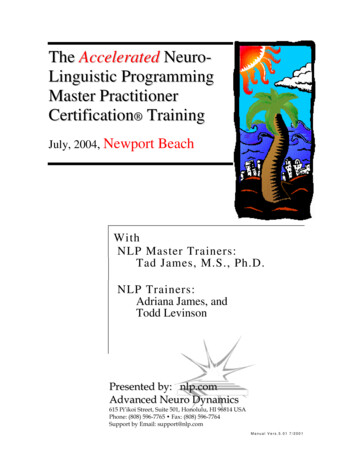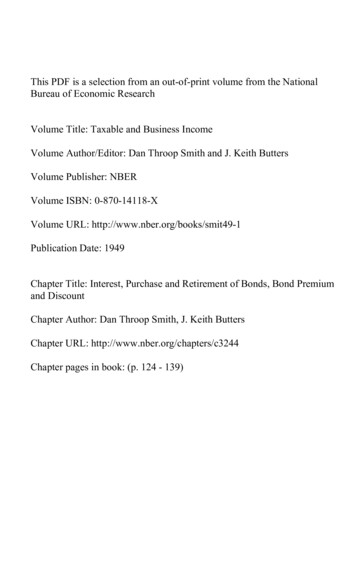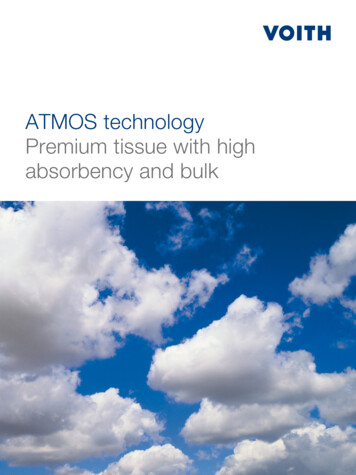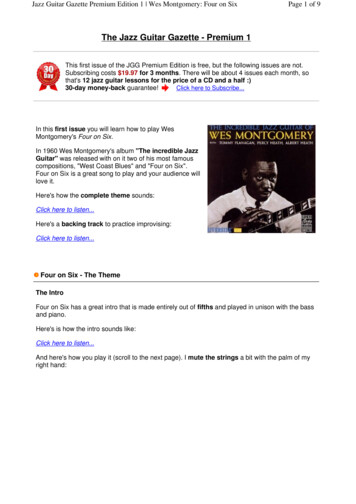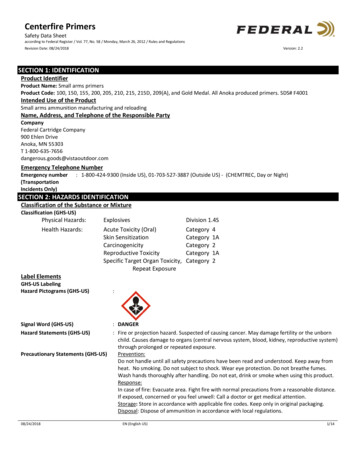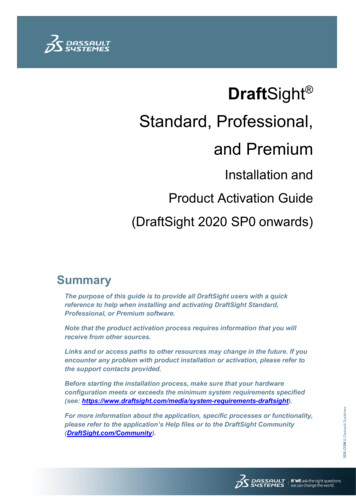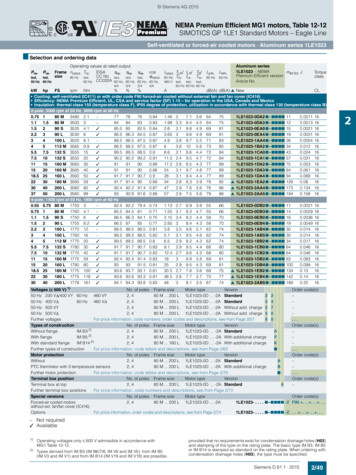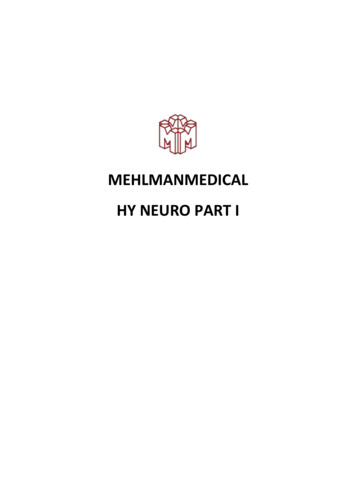
Transcription
MEHLMANMEDICALHY NEURO PART I
MEHLMANMEDICAL.COMHY Neuro Part I –Purpose of this review is not to be an unabridged, superfluous, 500-page neuro textbook for MS1 and MS2; the purpose isto increase your USMLE and Neuro shelf scores via concise factoid consolidation.-33F 1-wk Hx of R-sided weakness L-sided inability to feel temperature/pain diminished vibratorysensation over R foot brisk R-sided reflexes R-sided Babinski sign; Dx? à answer on NBME isBrown-Sequard syndrome secondary to viral infection.-59F metastatic cancer in pain crying “wants to die”; Q asks most likely reason for wanting todie; answer “inadequate pain control”; “major depression” is wrong answer; must address painmanagement in cancer patients.-42F 3-month Hx of insomnia discomfort while lying in bed; next best step in management? àcheck serum iron and ferritin levels; student says wtf? à restless leg syndrome is most often causedby iron deficiency.-42F 3-month Hx of insomnia discomfort while lying in bed serum iron and ferritin are normal;next best step in management? à D2 agonist – i.e., pramipexole or ropinirole, etc.-Patient with restless leg syndrome is at increased risk for what disease later in life? à answer onUSMLE Parkinson disease (if D2 agonist can Tx, then lack of dopamine transmission may be etiologyin some patients).-58M loses consciousness while shaving tilt-table test shows no abnormalities; Dx? à NBMEwants “carotid sinus hypersensitivity” as answer. If tilt-table test ( ), answer vasovagal syncope.-45F fundoscopy shows hard exudates cotton wool spots scattered hemorrhages; Dx? à diabeticretinopathy.-Medication that can cause tardive dyskinesia that is not an antipsychotic? à answer metoclopramide (D2 antagonist); can also prolong QT interval and cause hyperprolactinemia.-Anti-depressant med causing seizures? à bupropion.-Frontal lobe injury in car accident; NBME asks which deficit is most likely to ensue; answer conceptual planning.MEHLMANMEDICAL.COM2
MEHLMANMEDICAL.COM-56M alcoholism acutely intoxicated B1 is administered; the latter decreases what mostsignificantly? à Neuro shelf wants “anterograde amnesia” as the answer; mnemonic for Wernicke A COW à Ataxia, Confusion, Ophthalmoplegia, Wernicke.-56M 3-day Hx of cutting from 12 beers a day down to 4; develops tremulousness; Tx? àchlordiazepoxide (delirium tremens); classic vignette is guy has surgery two days later hastachycardia, tremulousness, and hallucinations (alcoholic hallucinosis).-50F high ESR and creatine kinase (CK) proximal muscle weakness /- muscle pain; Dx? àpolymyositis.-50F high ESR no mention of high CK or weakness in the vignette muscle pain muscle stiffness;Dx? à polymyalgia rheumatica (PMR).-Main difference between PMR and polymyositis? à PMR has no proximal muscle weakness anormal creatine kinase; polymyositis has high CK and weakness; pain stiffness of muscles can beseen in both conditions, but classically PMR. For USMLE vignettes neuro shelf, focus on whetherthere’s weakness or elevated CK.-48F high ESR and creatine kinase (CK) proximal muscle weakness /- muscle pain; next best step inDx? à Neuro shelf wants either “anti-Jo1 / -Mi2 antibodies” or “electromyography and nerveconduction studies” as the answer to Dx polymyositis. After these, do muscle biopsy can beperformed for definitive Dx. In contrast, no specific Dx test is used for PMR.-59F temporal headache muscle pain and stiffness high ESR; Dx? à temporal arteritis polymyalgia rheumatica à next best step? IV methylprednisolone first, followed by temporal arterybiopsy.-68M Hx of prostate cancer now has neurologic findings; next best step in Dx? à MRI of spine tolook for mets à however if corticosteroids are listed, choose these before MRI à for spinal cordcompression on NBME (from cancer or trauma), choose steroids first if listed.-65F breast cancer neurologic findings; next best step? à answer on Neuro NBME is “intravenoushigh-dose dexamethasone.”-72M prostate cancer neurologic findings; Dx? à answer “epidural spinal cord compression” dueto spinal mets à do steroids first (if listed), then MRI.MEHLMANMEDICAL.COM3
MEHLMANMEDICAL.COM-Patient has brain cancer; next best step? à steroids.-How to Dx brain cancer? à answer contrast head CT (done for cancer and abscess).-How to Dx brain bleed? à answer non-contrast CT (always done for intracranial bleeds).-Epidural hematoma; next best step after CT confirms? à answer intubation and hyperventilationon Neuro NBME. After this is done, craniotomy is the answer.-Subdural hematoma; next best step after CT? à Answer craniotomy on NBME, not observation.-What do you see on non-contrast CT with epidural vs subdural? à epidural hematoma lens-shapedbleed; subdural crescent-shaped.-Blood pressure of 220/120 confusion; Dx Tx? à Hypertensive encephalopathy; give IV sodiumnitroprusside à this question is asked on Neuro form 1.-BP of 220/120 sodium nitroprusside administered; now patient has confusion; Dx? à cyanidetoxicity caused by nitroprusside.-Drug that can be given to prevent vasospasm after a subarachnoid hemorrhage (SAH)? à nimodipine(dihydropyridine CCB).-Severe headache stiff neck; Dx? à SAH (can cause meningism, similar to meningitis).-Brain bleed in patient with Alzheimer; Dx? à amyloid angiopathy (intracerebral hemorrhage).-87F Alzheimer low-grade fever delirium; next best step? à answer do urinalysis to look for UTIas cause of delirium.-Viral infection tinnitus vertigo /- neurosensory hearing loss à labyrinthitis.-Viral infection vertigo à vestibular neuritis.-Tx for acute flare of MS à IV steroids (oral is wrong and can make flares worse).-Tx between flares of MS (the patient must by asymptomatic) à IFN-beta (interferon beta).-Tx for spasticity in MS à baclofen (GABA-B receptor agonist).-Incontinence in MS à urge (hyperactive detrusor; detrusor instability).-Mechanism for MS? à T cell-mediated attack against oligodendrocytes.-How to Dx MS? à MRI is gold standard; choose MRI over CSF IgG oligoclonal bands.-27F intermittent headaches blurry vision; Dx? à optic neuritis (multiple sclerosis) à student says“why the headaches?” Yeah, I know. Weird. But it’s on the NBME. You need to know optic neuritis isMEHLMANMEDICAL.COM4
MEHLMANMEDICAL.COMHY in MS and means inflammation of cranial nerve II à presents as blurry vision, or change in colorvision, or Marcus Gunn pupil (relative afferent pupillary defect).-Most specific eye finding in MS à medial longitudinal fasciculus (MLF) syndrome à aka internuclearophthalmoplegia (INO) à when you abduct to one side, you activate CN VI on that side, whichrequires the contralateral CN III to activate in order to adduct à the side that cannot adduct is theside that’s fucked up; the normal side will have nystagmus.-How to differentiate CN III lesion from INO? à INO patients can converge normally.-20F stiffness of hands frontal balding impaired relaxation of hypothenar muscles; Dx? àmyotonic dystrophy (CTG TNR disorder).-Cancer patient on cisplatin or vincristine develops neuropathy; Dx? à answer toxic neuropathy(chemotherapy-induced neuropathy); these drugs are neurotoxic.-Confusion and/or seizure due to electrolyte disturbance; Dx? à hypo-/hypernatremia andhypercalcemia all cause CNS dysfunction.-Confusion in the setting of high BUN and creatinine; Dx? à uremic encephalopathy.-Floppy baby syndrome; Dx and location of CNS/PNS affected? à Werdnig-Hoffmann syndrome(spinal muscular atrophy); anterior horns affected.-Antipsychotic medication started muscle rigidity no fever; Dx Tx? à acute dystonia, notneuroleptic malignant syndrome (because no fever); Tx with benztropine (muscarinic receptorantagonist) or diphenhydramine (1st gen H1 blocker, which has strong anti-muscarinic side-effects).-Antipsychotic medication started abnormal eye movements stiff neck; Dx? à acute dystonia(oculogyric crisis torticollis).-Antipsychotic medication started muscle rigidity fever; Dx Tx? à neuroleptic malignantsyndrome; give dantrolene (inhibits ryanodine channel).-Antipsychotic med restlessness; Dx Tx? à akathisia; Tx with propranolol.-Antipsychotic med bradykinesia; Dx Tx? à drug-induced Parkinsonism; Tx with amantadine orpropranolol.-Antipsychotic med abnormal tongue movements; Dx Tx? à tardive dyskinesia; stop antipsychotic switch to atypical.-Tx for diabetic neuropathic pain? à answer TCA (i.e., amitriptyline). Second-line is gabapentinMEHLMANMEDICAL.COM5
MEHLMANMEDICAL.COM-Tx for herpetic / post-herpetic neuralgia (i.e., from shingles)? à gabapentin-82M diabetic neuropathic pain already taking carbamazepine gabapentin to no avail; next beststep? à switch the meds to nortriptyline (a TCA) à student then asks, “Wait, I thought you said TCAsare first-line. Why does this Q have the guy on those two meds then?” à two points: 1) we don’t likegiving TCAs to elderly because of their anticholinergic and anti-alpha-1 side-effects, so this vignettehappen to try other agents first, but if you’re asked first-line, always choose TCA; and 2) if we do givea TCA to an elderly patient, we choose nortriptyline because it carries fewer adverse effects.-How to differentiate cluster headache from trigeminal neuralgia? à cluster will be a male 20s-40swith 11/10 lancinating pain behind the eye waking him up at night (he may pace around the roomuntil it goes away); details such as lacrimation and rhinorrhea are too easy and will likely not show upon the shelf. In contrast, trigeminal neuralgia will be 11/10 lancinating pain behind the eye (or alongthe cheek / jaw if V2 or V3 branches affected; it’s when V1 is affected that this diagnoses are morereadily confused) à TN is brought on by a minor stimulus such as brushing one’s hair or teeth, or agust of wind.-Tx and prophylaxis for cluster headache? à Tx 100% oxygen; prophylaxis verapamil.-Tx and prophylaxis for trigeminal neuralgia? à Tx goes away on its own because it lasts onlyseconds; prophylaxis carbamazepine.-Tx and prophylaxis for migraine? à Tx NSAID, followed by triptan (triptans are NOT prophylaxis;they are for abortive therapy only after NSAIDs); prophylaxis propranolol.-32M diffuse headache relieved by acetaminophen sleep; Dx? à answer tension-type headache;Tx rest taper caffeine (if taking it).-Other HY uses for propranolol?oMigraine prophylaxis (FM form gives patient with HTN migraine; answer propranolol)oAkathisia (with antipsychotic use)oThyroid storm (decreases peripheral conversion of T4 to T3)oEssential tremor (bilateral resting tremor in young adult; autosomal dominant; patient willself-medicate with EtOH, which decreases tremor).oHypertension idiopathic tremor (i.e., tremor need not be essential if patient has HTN àanswer on FM form is “beta-adrenergic blockade” for the HTN Tx).MEHLMANMEDICAL.COM6
MEHLMANMEDICAL.COM-oEsophageal varices prophylaxis (patients at risk of bleeds)oHypertrophic obstructive cardiomyopathy (increases preload à decreases murmur)oSocial phobia47M bitemporal hemianopsia; most likely tumor? à prolactinoma (most common pituitary tumorin adults).-8M bitemporal hemianopsia; most likely tumor? à craniopharyngioma (most common pituitarytumor in children; some sources argue not true pituitary tumor because it’s derived from Rathkepouch, which is the roof of the primitive pharynx).-Most common primary brain cancer in children? à pilocytic astrocytoma à solid cystic on MRI; hasRosenthal fibers à not aggressive.-3F morning vomiting truncal ataxia; Dx? à medulloblastoma of cerebellar vermis.-Most common primary brain cancer in adults? à glioblastoma multiforme (butterfly glioma) à areasof necrosis hemorrhage (large, irregular mass on head CT); often presents with seizure.-44F SLE irregular ring-enhancing lesion seen on head CT; Dx? à primary CNS lymphoma, not Toxo.-Neuro shelf asks Tx for Toxo; answer? à sulfadiazine pyrimethamine; prophylaxis is trimethoprim sulfamethoxazole. For PJP, TMP/SMX is Tx and prophylaxis. Yes, this is asked on Neuro shelf.-Neonate intracranial calcifications chorioretinitis hydrocephalus; Dx? à Congenital Toxo.-Neonate intracranial calcifications deafness hepatomegaly rash; Dx? à CMV.-Neonate with bilateral deafness due to maternal infection no other info given; Dx? à answer congenital CMV.-CNS tumors seen in neurofibromatosis? à oligodendroglioma ependymoma optic nerve glioma inNF1; in NF2, meningioma. These may overlap, but be aware that these tumors can merely occur ineither NF, period.-50F jaw pain headaches normal ESR; Dx? à temporal mandibular joint syndrome; if ESR is high,answer is jaw claudication caused by temporal arteritis.-40F being treated for TB has neurologic findings in extremities /- seizure; Dx? à B6 (pyridoxine)deficiency caused by isoniazid.-65F metastatic breast cancer suprapubic mass decreased sphincter tone pain over lumbarvertebrae on fist percussion; Dx? à answer metastases to cauda equina.MEHLMANMEDICAL.COM7
MEHLMANMEDICAL.COM-44M saddle anesthesia late urinary incontinence; Dx? à cauda equina syndrome à bundle ofspinal nerves and rootlets arising from the conus medullaris).-44M perianal anesthesia early urinary fecal incontinence; Dx? à conus medullaris syndrome àbulbous end of the spinal cord conus medullaris.-48M burns his thumb; pain sensed via which dermatome? à answer C6; lateral digits primarilyC6; middle finger C7; medial digits primarily C8.-13F 2-day Hx of lower limb paresthesias CSF protein 95 mg/dL CSF leukocyte count 4/uL; Dx? àanswer Guillain-Barre syndrome (GBS). USMLE will often not mention preceding infection, especiallyat 2CK level.-What does CSF show in GBS? à albuminocytologic dissociation (high protein but normal cells).-24M weakness proximally and distally in lower limbs weakness distally in upper lim
USMLE Parkinson disease (if D2 agonist can Tx, then lack of dopamine transmission may be etiology in some patients). . Rosenthal fibers à not aggressive. - 3F morning vomiting truncal ataxia; Dx? à medulloblastoma of cerebellar vermis. - Most common primary brain cancer in adults? à glioblastoma multiforme (butterfly glioma) à areas of necrosis hemorrhage (large, irregular mass .

